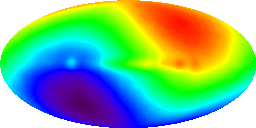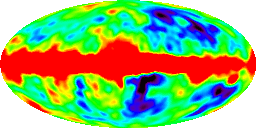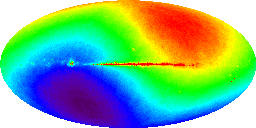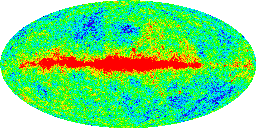
Fluctuations in the Cosmic Microwave Background

The cosmic microwave background is the afterglow radiation left over from
the hot Big Bang. Its temperature is extremely uniform all over the sky.
However, tiny temperature variations (at the part per million level) can offer
great insight into the origin, evolution, and content of the universe.

Uniformity of the Cosmic Microwave Background
One of the most striking features about the cosmic
microwave background is its uniformity. Unlike the optical sky with
many bright regions, the microwave background temperature varies only slightly
across the sky. While the Big Bang Theory
explains the origin of the cosmic microwave background radiation, it does not
explain its uniformity. The Inflation Theory
was proposed to explain this uniformity
and to resolve other paradoxes associated with the Big Bang.

Fluctuations in the Cosmic Microwave Background
If you were approaching the Earth on a spaceship, the first thing
you would notice is that the planet is spherical. As you drew closer
to the Earth, you would see the surface divide into continents
and oceans. You would need to study the Earth's surface very
carefully to see the mountains, cities, forests and deserts
that cover the continents.
Similarly, when cosmologists first looked at the microwave sky, thirty years
ago, they noticed it was nearly uniform. As observations improved, they
detected the dipole anisotropy. Finally, in 1992,
the Cosmic Background Explorer
(COBE)
satellite made the first detection analogous to seeing "mountains on the surface
of the Earth": it detected cosmological fluctuations in the microwave
background temperature. Several members of the MAP science team help to build
and lead the COBE program. COBE's detection was confirmed by the
Far InfraRed Survey (FIRS)
balloon-borne experiment.
Fluctuations seen by COBE
 [Enlarged view]
[Enlarged view]
 [Enlarged view]
[Enlarged view]
 [Enlarged view]
[Enlarged view]
This figure, produced by the COBE science team, shows three false color images
of the sky as seen at microwave frequencies. The orientation of the maps are
such that the plane of the Milky Way runs horizontally across the center of
each image. The top figure shows the temperature of the microwave sky in a
scale in which blue is 0 Kelvin (absolute zero) and red is 4 Kelvin. Note
that the temperature appears completely uniform on this scale. The actual
temperature of the cosmic microwave background is 2.728 Kelvin. The middle
image is the same map displayed in a scale such that blue corresponds to 2.724
Kelvin and red is 2.732 Kelvin. The "yin-yang" pattern is the dipole
anisotropy that results from the motion of the Sun relative to the rest frame
of the cosmic microwave background. The bottom figure shows the microwave sky
after the dipole anisotropy has been subtracted from the map. This removal
eliminates most of the fluctuations in the map: the ones that remain are
thirty times smaller. On this map, the hot regions, shown in red, are 0.0002
Kelvin hotter than the cold regions, shown in blue.
There are two main sources for the fluctuations seen in the last figure:
- Emission from the Milky Way dominates the equator of the map but is
quite small away from the equator.
- Fluctuating emission from the edge of the visible universe dominates the
regions away from the equator.
- There is also residual noise in the maps from the instruments themselves,
but this noise is quite small compared to the signals in these maps.
These cosmic microwave temperature fluctuations are believed to trace
fluctuations in the density of matter in the early universe, as they were
imprinted shortly after the Big Bang. This being the case, they reveal a
great deal about the early universe and the origin of
galaxies and large scale structure in the universe.
Fluctuations seen by MAP?
 [Enlarged view]
[Enlarged view]
 [Enlarged view]
[Enlarged view]
 [Enlarged view]
[Enlarged view]
This figure shows one of our computer simulations of what we think the MAP
experiment could plausibly detect. Note that MAP should be able to detect
much finer features than are visible in the COBE maps of the sky. This
additional angular resolution allows scientists to
infer a great deal of additional information, beyond that supplied by COBE,
about conditions in the early universe.

 Back to the Introduction to Cosmology Page
Back to the Introduction to Cosmology Page
 Back to the MAP Home Page
Back to the MAP Home Page
Please help us make this web site more useful and enjoyable by telling us
what you would like to see at this site:
 David N. Spergel / dns@astro.princeton.edu
David N. Spergel / dns@astro.princeton.edu
Gary Hinshaw / hinshaw@stars.gsfc.nasa.gov
Charles L. Bennett / bennett@stars.gsfc.nasa.gov
Last updated: March 20, 1996




 [Enlarged view]
[Enlarged view] [Enlarged view]
[Enlarged view] [Enlarged view]
[Enlarged view] [Enlarged view]
[Enlarged view] [Enlarged view]
[Enlarged view] [Enlarged view]
[Enlarged view]
 Back to the Introduction to Cosmology Page
Back to the Introduction to Cosmology Page
 Back to the MAP Home Page
Back to the MAP Home Page
 David N. Spergel / dns@astro.princeton.edu
David N. Spergel / dns@astro.princeton.edu